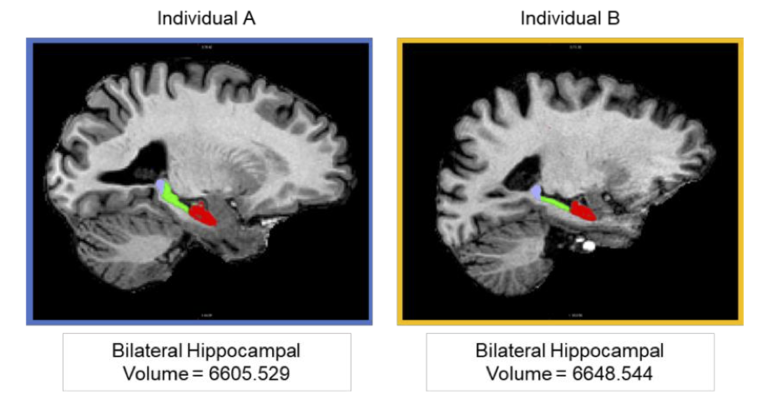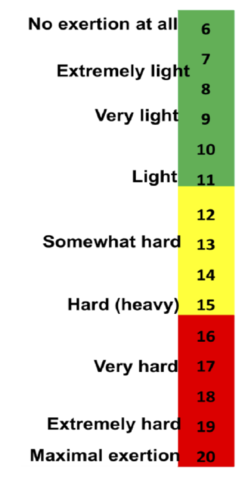Aging is commonly associated with a decline in cognitive abilities, including the potential shrinking of key brain regions such as the prefrontal cortex and hippocampus (see Figure 1 for an example of the Hippocampus brain region). As we age, our brain’s structure and neuron communication deteriorate, leading to what is perceived as ‘natural’ memory loss. This can range from momentarily forgetting details of an event but recalling them later, to more severe memory impairments seen in conditions like Alzheimer’s disease, where entire events are permanently forgotten.

As shown in Figure 1, the variability in hippocampal volume among individuals of the same age highlights differences that may be attributable to lifestyle factors such as health habits. The good news? A practical, accessible, and inexpensive remedy is within our reach: physical activity (PA). You might have heard from social media, TV news, or magazines that engaging in PA, particularly at a certain intensity, can stimulate the growth of new neurons and build a denser network of capillaries in the brain, providing added nourishment to the brain and keeping it sharp. When the brain remains young and healthy, the benefits could be extensive: not only do work performance and learning speed improve, but concentration, memory, and creativity could also get a boost.
PA is essential not only for improving physical fitness but also for boosting cognitive and brain health. Interestingly, even a single session of aerobic exercise lasting at least 20 minutes can temporarily improve cognitive performance [1-3]. Consequently, it is necessary to make a concerted effort to integrate PA into your daily routine. But which intensity of PA maximizes these benefits? This blog post will explore how different intensities of PA (moderate vs. vigorous) impact cognitive and brain health, offering actionable advice to help older adults keep their brains sharp and active.
Defining Moderate and Vigorous-Intensity Physical Activity
Moderate-intensity PA elevates the heart rate to 55-69% of the adjusted maximum heart rate, which can be calculated using formulas like the Tanaka method: HRmax = 208 – (0.7 age) [4]. For example, for a 63-year-old female, the estimated HRmax is 163.9 beats per minute (bpm) [calculated as 208 – (0.7 63)]. This equation provides a more precise estimation for older adults compared to the traditional approach (HRmax = 220 – age) [5]. Using the Tanaka method, the target heart rate range for moderate intensity for a 63-year-old female is approximately 91 bpm (0.55 163.9) to 114 bpm (0.69 163.9). Examples of moderate-intensity PA include brisk walking or gentle cycling. Intensity can also be estimated by using a Rating of Perceived Exertion (RPE) of 11-13 on Borg’s 6-20 scale (see Figure 2), or by achieving 40-59% of Heart Rate Reserve (HRR) (see calculator below). These thresholds are ideal for maintaining activity over longer durations, enhancing cardiovascular health and endurance without excessive physical strain.

When assessing intensity subjectively, moderate-intensity activity allows you to talk but not sing, distinguishing it from light activity, where you can talk and sing comfortably. In contrast, during vigorous-intensity activity, talking becomes difficult and is often interrupted by large breaths.
You can calculate your maximum and target heart rates using online tools like the Good Calculators Heart Rate Calculator. This site offers a comprehensive heart rate calculator that incorporates various methods, including the standard and Tanaka methods, to determine your maximum heart rate, target heart rate, and training zones based on age, resting heart rate, and desired intensity.
Impacts of Physical Activity on Cognitive and Brain Health
Exercise and neuroimaging research using fMRI consistently demonstrates that both moderate and vigorous intensities of long-term PA contribute to cognitive improvements, possibly through PA-induced changes in brain structure and functional network connectivity. An exercise intervention study by Erickson et al. [6] found that older adults (ages 55-80) who participated in one year of moderate-intensity aerobic walking exercise training experienced increased hippocampal volume, which was associated with greater blood serum levels of BDNF, thought to be a key mediator of PA’s enhancing effects on learning and memory. Findings from a recent meta-analysis further highlight that exercise interventions lasting over 6 months, with a maximum of 150 minutes per week, positively affect hippocampal volume, with the strongest effect observed in individuals aged 65 years or older. Conversely, interventions with more than 150 minutes per week did not show positive effects [7]. Moreover, the same type of exercise intervention, previously described by Erickson et al. [6], was conducted by Voss and her colleagues [8]. It demonstrated that older participants (ages 55-80) who were engaged in a year-long moderate-intensity walking program exhibited increased functional connectivity within the brain networks that include the hippocampus and prefrontal cortices, linked with improved executive function.
Similar findings were reported by McGregor et al. [9] from a vigorous-intensity PA intervention trial, where older adults (ages 60-80) in a 12-week vigorous aerobic stationary cycling exercise group displayed increased functional connectivity between the hippocampus and primary sensory motor cortices compared to the control group. These increases in functional connectivity may be associated with improved motor performance.
Collectively, these findings highlight that engaging in sufficient doses of PA, reaching at least the threshold of moderate-intensity for older adults, can significantly enhance brain structural and functional integrity for brain regions vulnerable to aging like the hippocampus. These neuroplastic changes induced by PA are linked to improvements in various cognitive domains, such as memory and executive function.
Recommendations for Physical Activity
For older adults aiming to delay brain aging, it is important to integrate a balanced mix of moderate and vigorous activities into daily routines, tailored to individual physical limitations and health conditions. The U.S. Department of Health and Human Services recommends that healthy older adults should aim for at least 150 minutes of moderate-intensity aerobic activity, such as brisk walking, or 75 minutes of vigorous-intensity aerobic activity, such as jogging, each week [10].
Conclusions
Selecting the appropriate intensity of PA can positively impact the cognitive and brain health of older adults. While both moderate and vigorous-intensity PA offer valuable benefits, understanding and applying the optimal intensity can further enhance these advantages, thereby supporting the maintenance of independence in daily activities as one ages. Always consult with a healthcare provider before starting a new PA regimen. Regular participation in personalized PA routines can lead to substantial improvements in cognitive and brain health, contributing to a happier, healthier later life.
Dr. Myungjin Jung, formerly a post-doctoral scholar at the University of Iowa Health, Brain & Cognition Lab, recently joined the Department of Kinesiology, Health Promotion and Recreation at the University of North Texas as a tenure-track assistant professor.
References
[1] Chang, Y. K., Labban, J. D., Gapin, J. I., & Etnier, J. L. (2012). The effects of acute exercise on cognitive performance: a meta-analysis. Brain Research, 1453, 87-101.
[2] Roig, M., Nordbrandt, S., Geertsen, S. S., & Nielsen, J. B. (2013). The effects of cardiovascular exercise on human memory: a review with meta-analysis. Neuroscience & Biobehavioral Reviews, 37(8), 1645-1666.
[3] Kamijo, K., Hayashi, Y., Sakai, T., Yahiro, T., Tanaka, K., & Nishihira, Y. (2009). Acute effects of aerobic exercise on cognitive function in older adults. Journals of Gerontology: Series B, 64(3), 356-363.
[4] Tanaka, H., Monahan, K. D., & Seals, D. R. (2001). Age-predicted maximal heart rate revisited. Journal of the American College of Cardiology, 37(1), 153-156.
[5] Fox S. M., III., Naughton J. P., Haskell W. L. (1971). Physical activity and the prevention of coronary heart disease. Annals of Clinical Research, 3, 404-432.
[6] Erickson, K. I., Voss, M. W., Prakash, R. S., Basak, C., Szabo, A., Chaddock, L., ... & Kramer, A. F. (2011). Exercise training increases size of hippocampus and improves memory. Proceedings of the National Academy of Sciences, 108(7), 3017-3022.
[7] Wilckens, K. A., Stillman, C. M., Waiwood, A. M., Kang, C., Leckie, R. L., Peven, J. C., ... & Erickson, K. I. (2021). Exercise interventions preserve hippocampal volume: A meta‐analysis. Hippocampus, 31(3), 335-347.
[8] Voss, M. W., Weng, T. B., Burzynska, A. Z., Wong, C. N., Cooke, G. E., Clark, R., ... & Kramer, A. F. (2016). Fitness, but not physical activity, is related to functional integrity of brain networks associated with aging. Neuroimage, 131, 113-125.
[9] McGregor, K. M., Crosson, B., Krishnamurthy, L. C., Krishnamurthy, V., Hortman, K., Gopinath, K., ... & Nocera, J. R. (2018). Effects of a 12-week aerobic spin intervention on resting state networks in previously sedentary older adults. Frontiers in Psychology, 9, 2376.
[10] U.S. Department of Health and Human Services. (2018). Physical Activity Guidelines for Americans, 2nd edition. Retrieved from https://health.gov/paguidelines/second-edition/pdf/Physical_Activity_Guidelines_2nd_edition.pdf